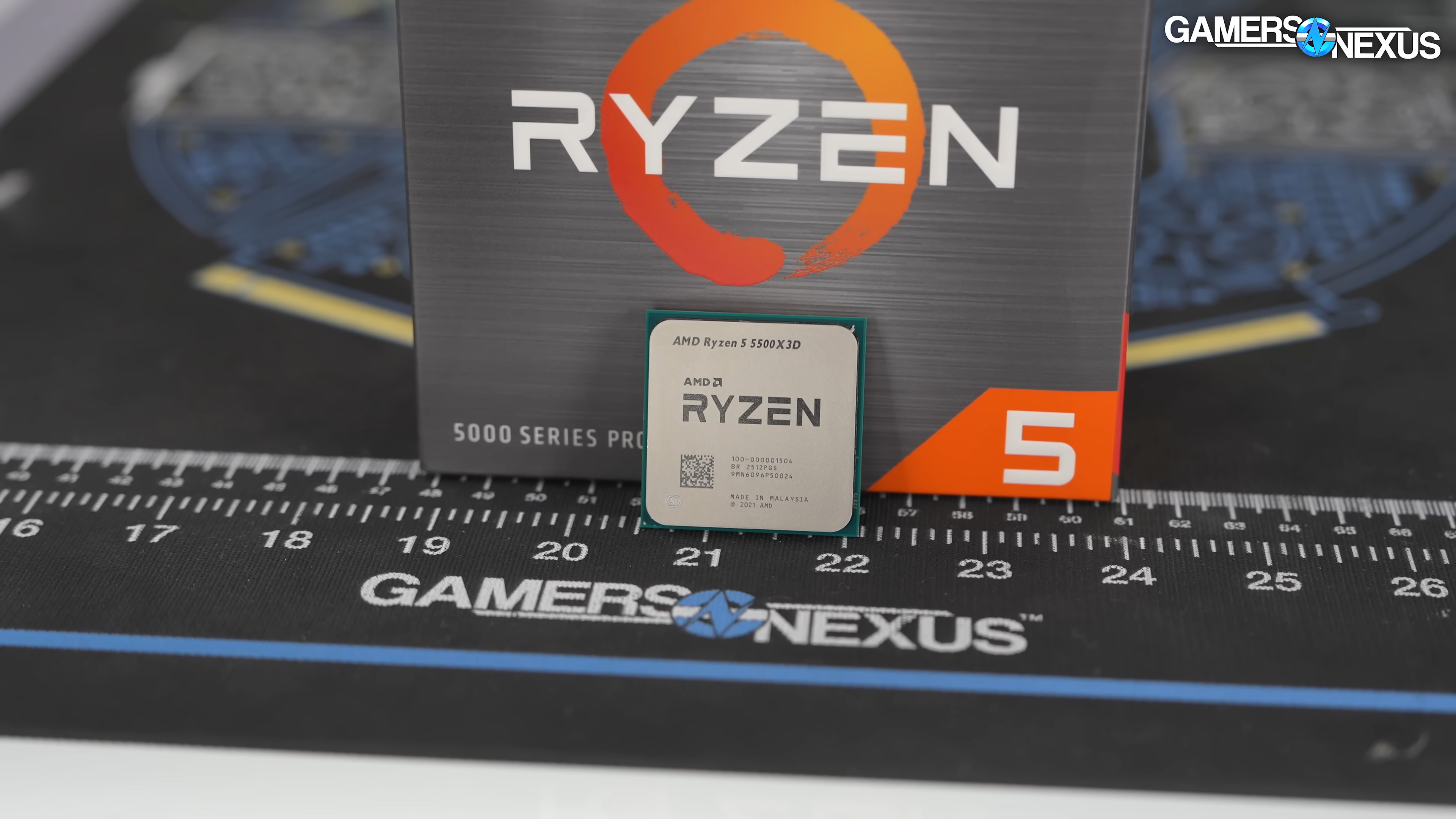
The 5500X3D likely takes fallout from the manufacturing process and then re-spins it as a new model, allowing AMD to salvage silicon
The Highlights
- The AMD Ryzen 5 5500X3D CPU is for the Latin America market and builds upon the AM4 X3D CPU lineage and is a 6-core, 12-thread part
- The 5500X3D isn’t a particularly good performer in things like production applications, compression, and decompression
- AMD is still launching AM4 CPUs, which is awesome since the socket is now nearly 10 years old
- Original MSRP: $240-$250 (approximately)
- Release Date: June 2025
Table of Contents
- AutoTOC
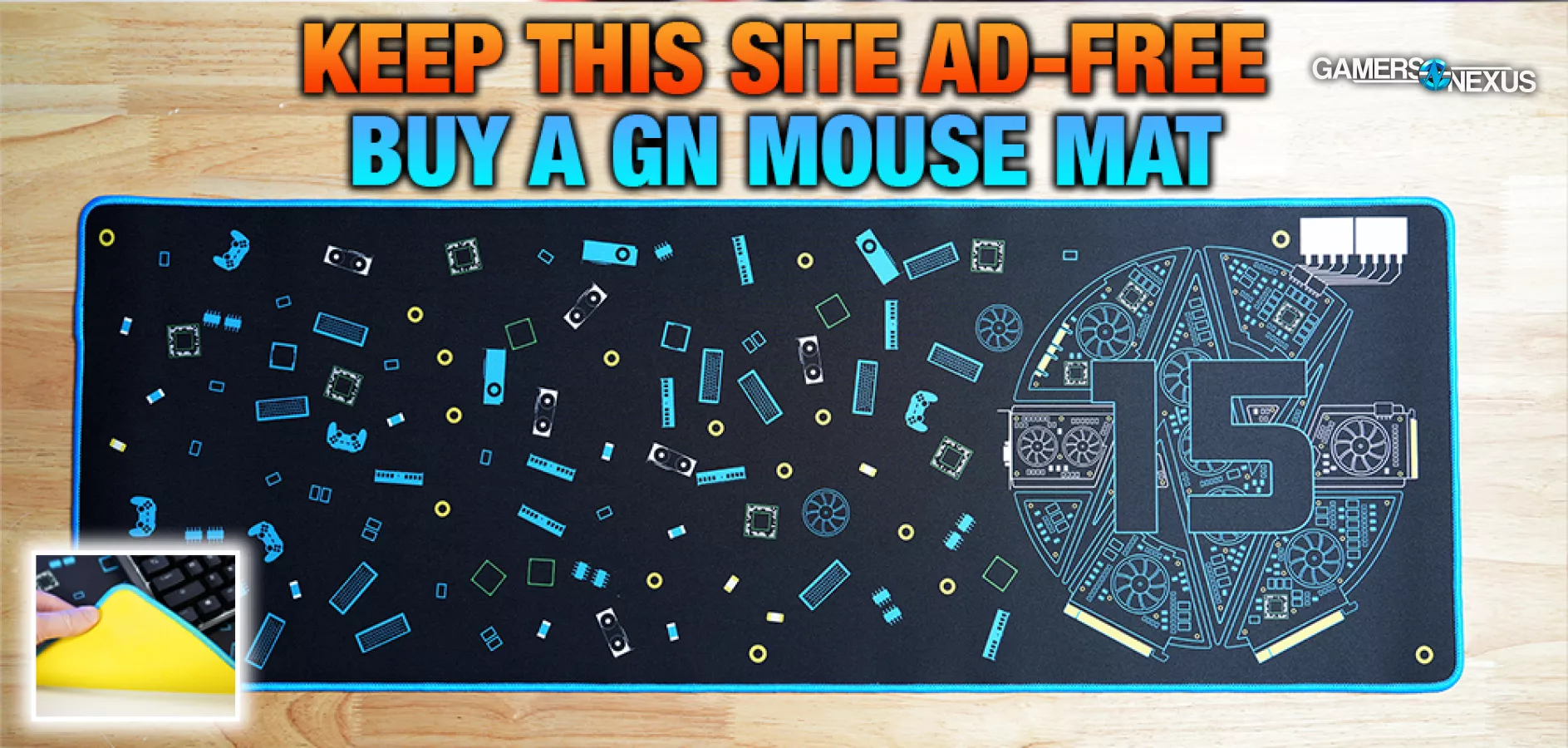
Intro
AM4 is the GOAT of motherboard sockets at this point. The socket launched in 2016 and was used for AMD’s first Ryzen CPUs in 2017, and AMD is still launching CPUs for it in 2025. The newest one is the Ryzen 5 5500X3D CPU, a 6-core, 12-thread part that follows other unexpected launches.
AMD launched the R7 5700X3D (read our review) in 2024 and the R5 5600X3D (exclusive to Micro Center) in 2023. The R5 5500X3D has a lower frequency than the 5600X3D and is exclusive to Latin America. Our viewer Leo in Brazil helped us buy one to review, and it’s currently priced at about $204 converted to USD and launched at around $240-$250 USD a couple months ago.
Editor's note: This was originally published on August 29, 2025 as a video. This content has been adapted to written format for this article and is unchanged from the original publication.
Credits
Test Lead, Host, Writing
Steve Burke
Testing
Patrick Lathan
Testing, Video Editing
Mike Gaglione
Camera
Tim Phetdara
Writing, Web Editing
Jimmy Thang
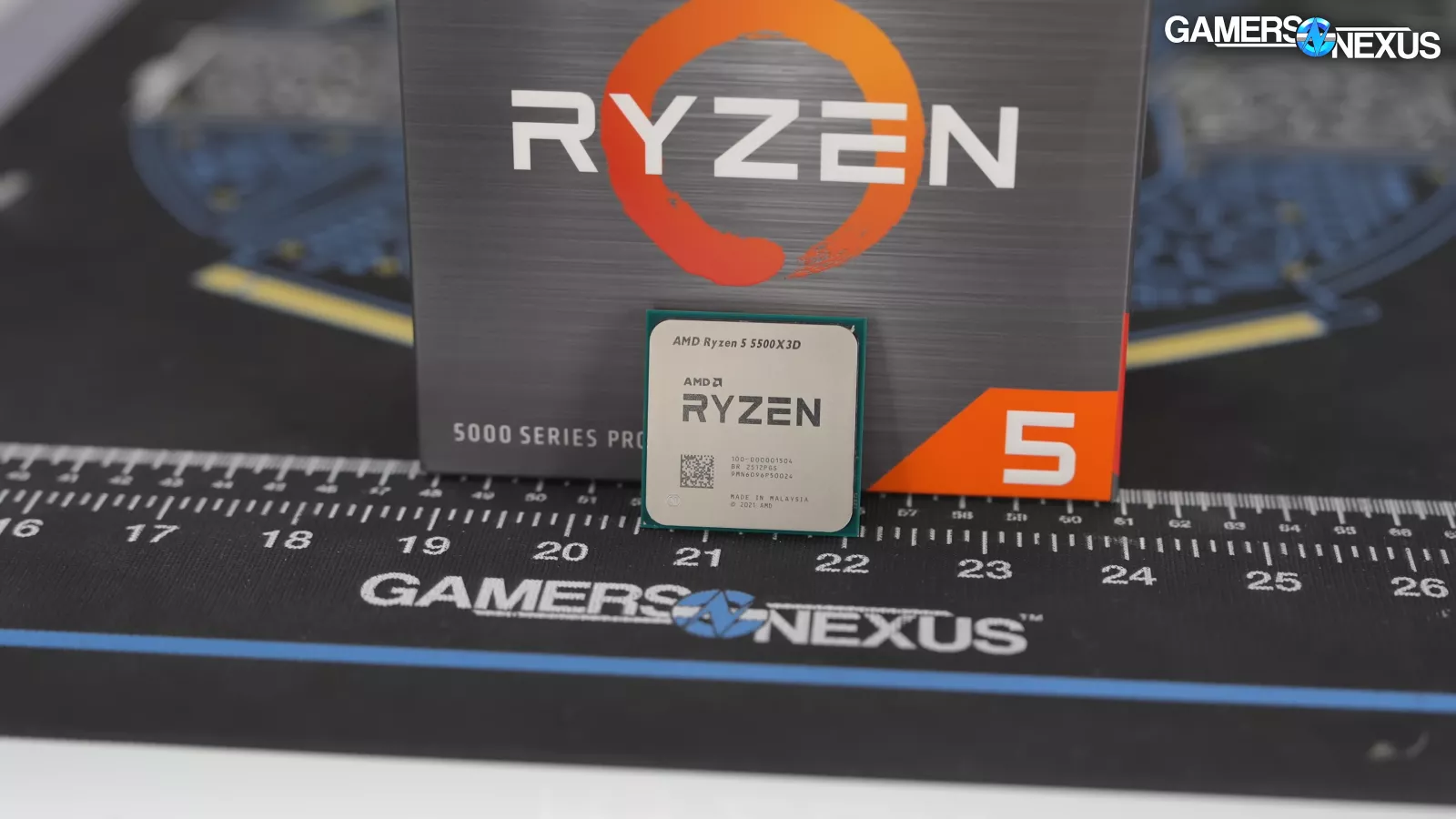
Today, we’re benchmarking the R5 5500X3D. We’re going to keep this set of benchmarks relatively simple and straight-forward: We’ll look primarily at gaming, frequency validation, and we’ll add some production benchmarks. We’re currently revamping and overhauling our efficiency testing as part of our regular bench suite update interval, so we won’t be running those numbers today.
Overview
We’ll start with a quick price comparison.
CPU Market Pricing Update
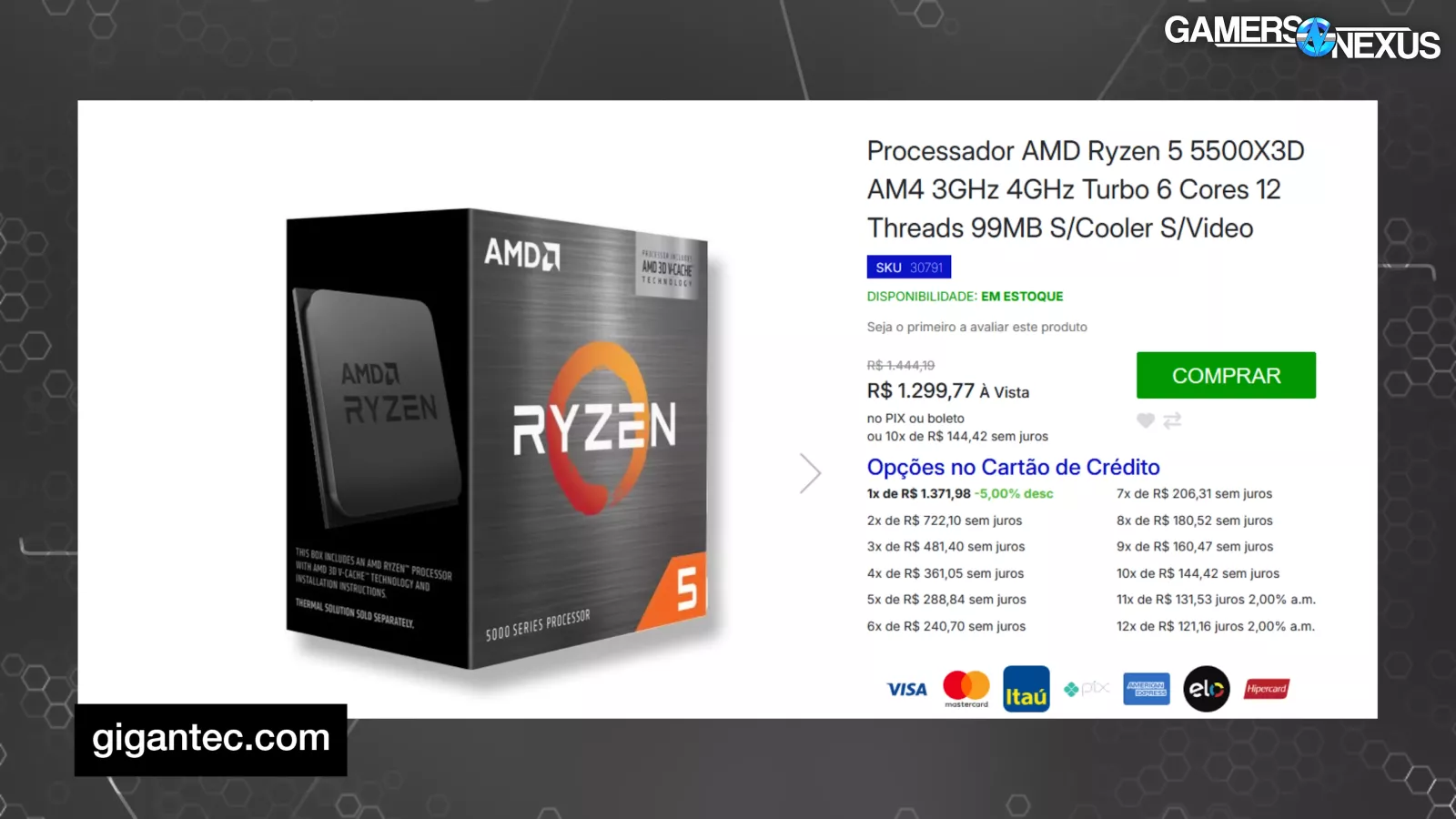
So again, the 5500X3D was about $240-$250 for our viewer, as seen in the screenshot above from the retailer who sold it.
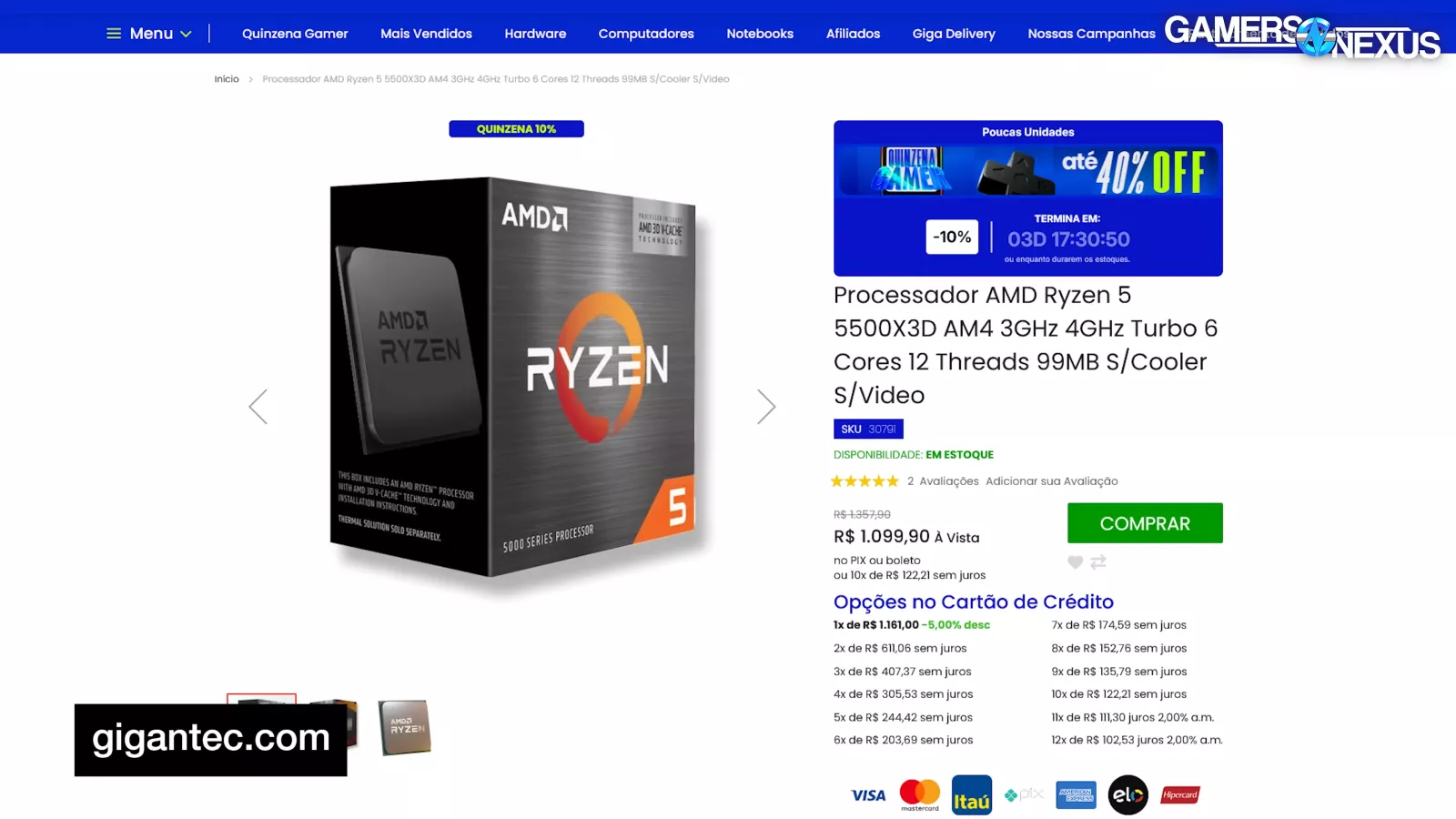
About a month or two later, it went down to $204. That’s still pretty expensive by US market standards, but we’re admittedly not very familiar with the Brazilian or South American markets where this is sold.
Starting with some pricing updates from the market we do know in the US, here’s what it looks like:
Currently, the Intel 265KF without IGP is $283 (apparently marked down from $300), the 9600X is $205, the 14600K (watch our review) is $190, the R7 7700 (watch our review) is $285, and the Ultra 5 225 from Intel is $212 (we haven’t tested this one). The 5800X3D (watch our review) is mostly gone from retailers in any reasonably priced capacity and the 5700X3D is also only available at higher prices and from third-party sellers now. To set the price for the high-end, a 9800X3D (read our review) is about $480.
These are US prices though. Checking the same website our viewer used, we found the 5600X for about the same price as the current 5500X3D price, the Intel 245K for almost exactly twice the current price of the 5500X3D, and the AMD R5 9600X for $270. Given these prices, the 5500X3D at its current $204 is one of the better prices on this particular website. But again, don’t take us as experts for this space. We only learned of this site a month ago.
Specs & Price
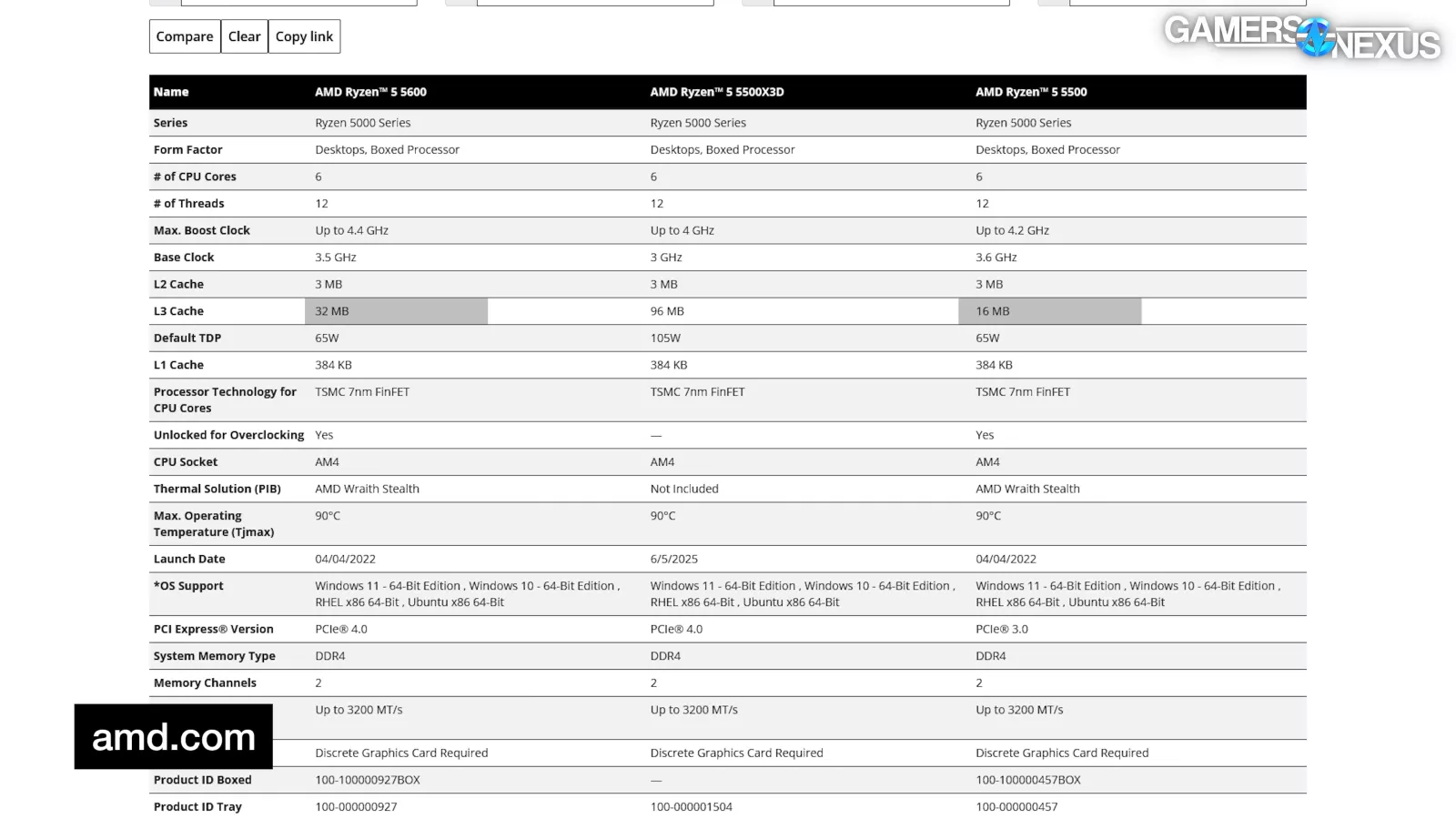
The AMD R5 5500 non-X3D (watch our review) had a major downside from the R5 5600, which was the cache: The 5500 had just 16 MB of L3 Cache, down from 32 MB on the R5 5600. This was a huge change. Despite having the same core and thread count, same 65W TDP, and frequencies which are overall close enough to be comparable, this loss of cache materialized heavily in gaming performance right away in most cases.
The 5500X3D has 96MB of L3 Cache, as we’ve come to expect from its class of CPU. It also has a 105W TDP, which increases its power budget; however, the 5500X3D’s clock speed is significantly lower than that of the 5600 (watch our review) and even 5500, at 3 GHz base and 4.0 GHz boost. This will be its biggest potential downside, but we’ve often seen that cache can make up for lower frequencies in gaming. If the CPU is a downbin or cobbled together from low-performing silicon, then these frequencies make sense as it might be comprised of chips that couldn’t hit higher targets. Likewise, it's possible if it's lower quality silicon that it could require more power to drive the frequencies it is maintaining.
The rest of the specs are familiar: The 5500X3D uses a 7nm FinFET process from TSMC, like the 5500/5600, uses the AM4 socket that’s been GOATed at this point, and is a 6-core, 12-thread part.
Frequency Validation - All-Core
We’ll start with frequency validation in Blender rendering to ensure the CPU is working as advertised.
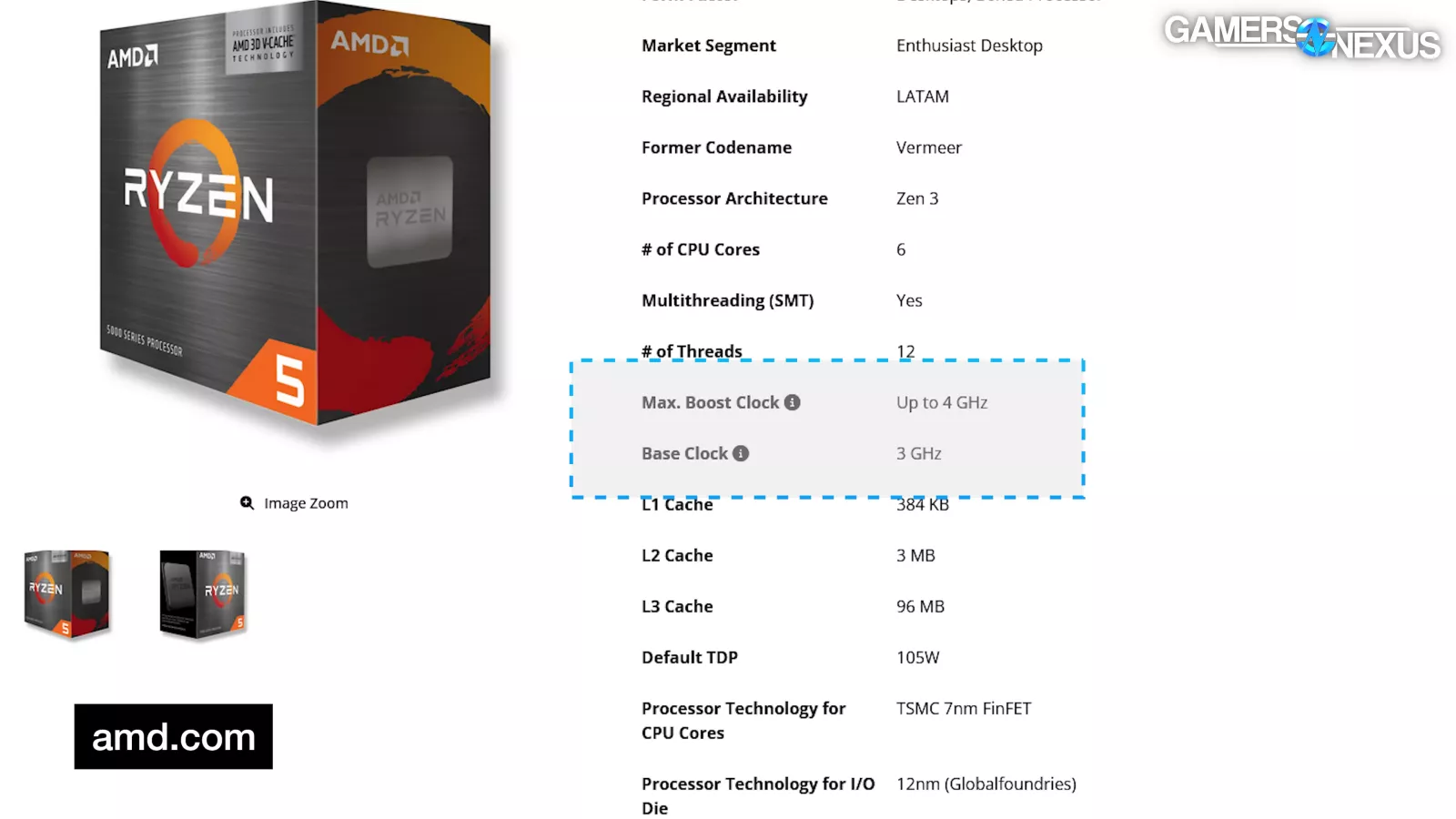
AMD’s spec sheet defines a 4GHz max boost and 3GHz base clock.
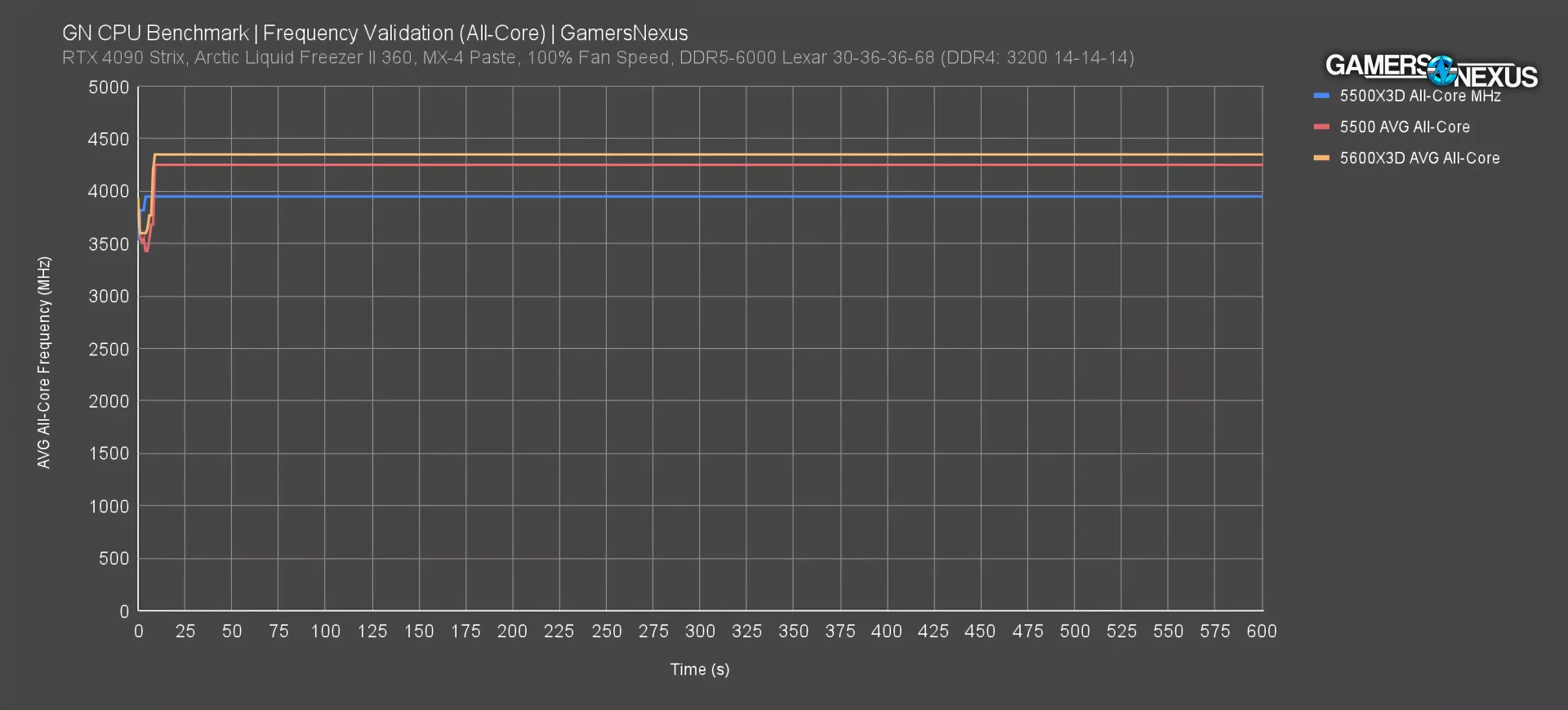
This all-core workload in Blender has the 5500X3D at 3950MHz, falling below the max advertised boost. This is expected for an all-core workload, as long as the CPU can hit the maximum advertised boost in a single-core workload.
The non-X3D R5 5500 CPU ran at 4250MHz, so it has a frequency advantage. The 5600X3D held a frequency of 4350MHz, making it the fastest of these 3 CPUs by frequency. All 3 of these are 6-core, 12-thread CPUs.
Frequency Validation - Single-Core
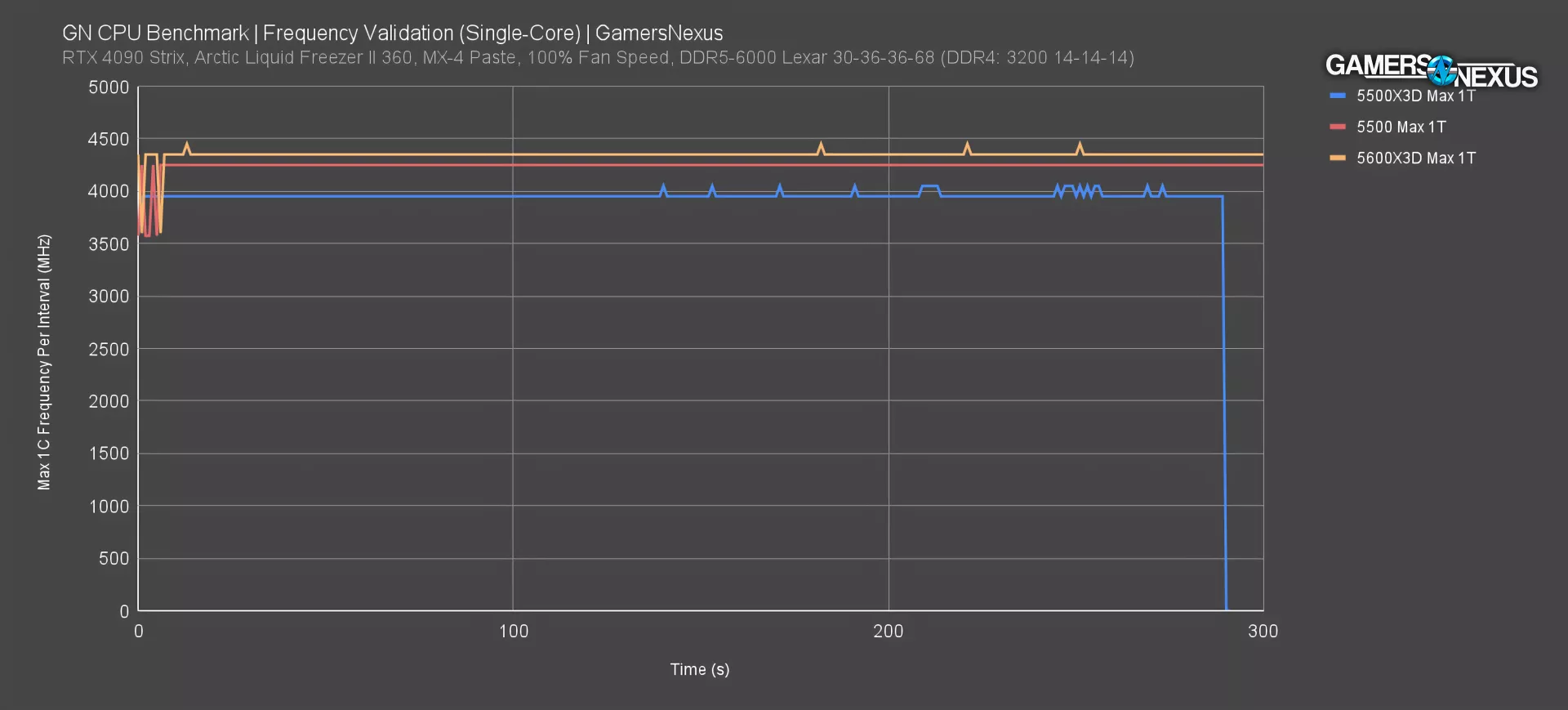
This next chart shows the maximum single core frequency per interval across a Cinebench 1T benchmark. The 5500X3D had a maximum frequency of 3950MHz, which means it falls short of AMD’s target of 4000 MHz maximum advertised boost. Technically, the spec sheet says “up to,” but that’s bullshit. AMD has done well since the 3000 series to ensure that its CPUs hit this advertised frequency in one of these two workloads for every other CPU we’ve tested for years, making this the first to fail in a long time. 50 MHz short of the target is disappointing. There are a few blips later in the test as tiles change, but the bulk of the test does not meet this target.
The 5500 non-X3D hit 4250 MHz again, with the 5600X3D at 4350 MHz.
5500X3D Gaming Benchmarks

Stellaris Simulation Time Benchmark
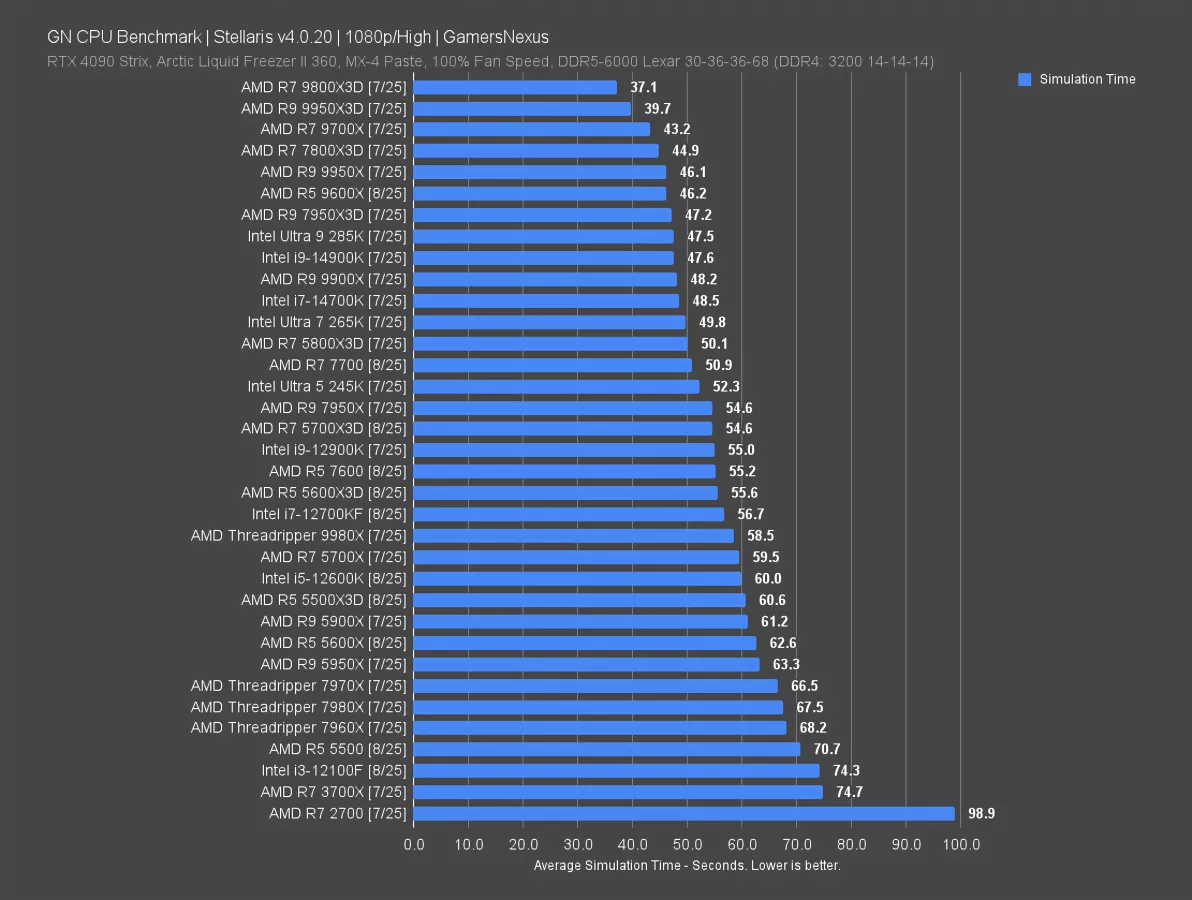
Stellaris simulation time is up first. This benchmark is CPU-intensive and also a gaming benchmark, but it’s useful for its real-world representation of something beyond framerate. This lets us look at the actual time required to simulate change in the game, meaning the impacts are felt in real time.
X3D stacks up like this: The 5800X3D is at 50 seconds required, the 5700X3D is at 55 seconds, the 5600X3D required 55.6 seconds, and the 5500X3D required about 61 seconds. The best performer is the 9800X3D at 37.1 seconds, illustrating significant scaling headroom.
Compared to the 5500X3D, the 5800X3D required 17% less time to complete the work. The 5700X3D required about 10% less time to complete the work, with the 5600X3D at about 8% required time reduced.
Intel’s 12600K (watch our review) has about the same performance as the 5500X3D. The 12700KF is a bit better, with the 245K (read our review) improved somewhat notably to 52 seconds, though we still don’t recommend the 200 series of CPUs.
Dragon’s Dogma 2 Benchmarks
Dragon’s Dogma 2 is up next. This is a relatively CPU-intensive benchmark.
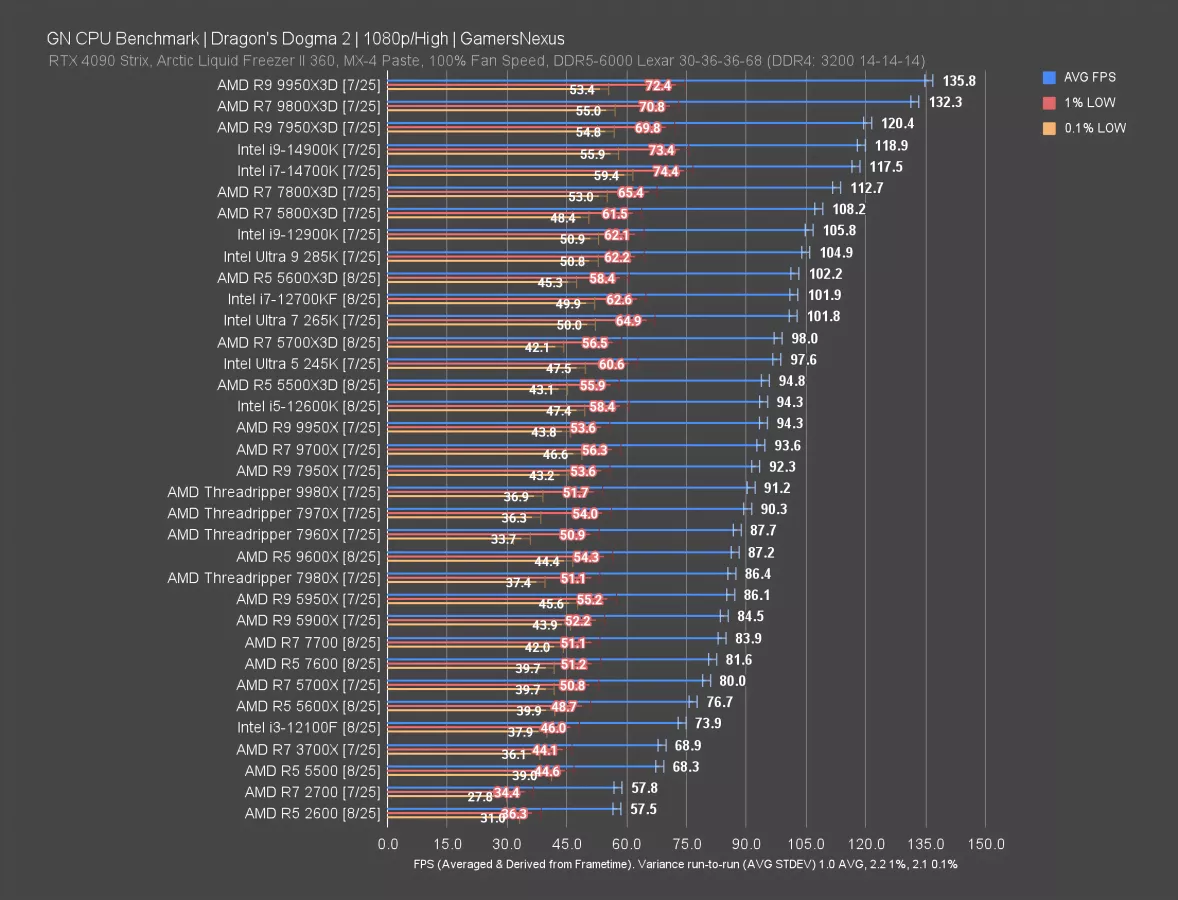
The 5500X3D ran at 95 FPS AVG here, with lows well-paced and frametimes in step with the average frametime. This has it around the same level as the 12600K, matching our Stellaris lineup. The 9800X3D shows clear room for scaling at 132 FPS AVG, or a 40% improvement over the 5500X3D, but would also require a new platform with a higher cost. The 5800X3D shows the best gaming capabilities of the AM4 socket with its 108 FPS AVG result, a 14% uplift over the new X3D part. The 5700X3D is closer to the 5500X3D, with the 5600X3D outperforming it. This isn’t abnormal and we’ve explained this over the years: The 5600X3D has a higher 4.4GHz turbo clock, with the 5700X3D at 4.1GHz due to the same 105W power budget being spread across more cores.
The 5500X3D is comparable to the 5700X3D, 245K, and 12600K in terms of performance. The 5700X3D still retains the benefit of more cores in situations where that’s useful.
Baldur’s Gate 3 Benchmarks
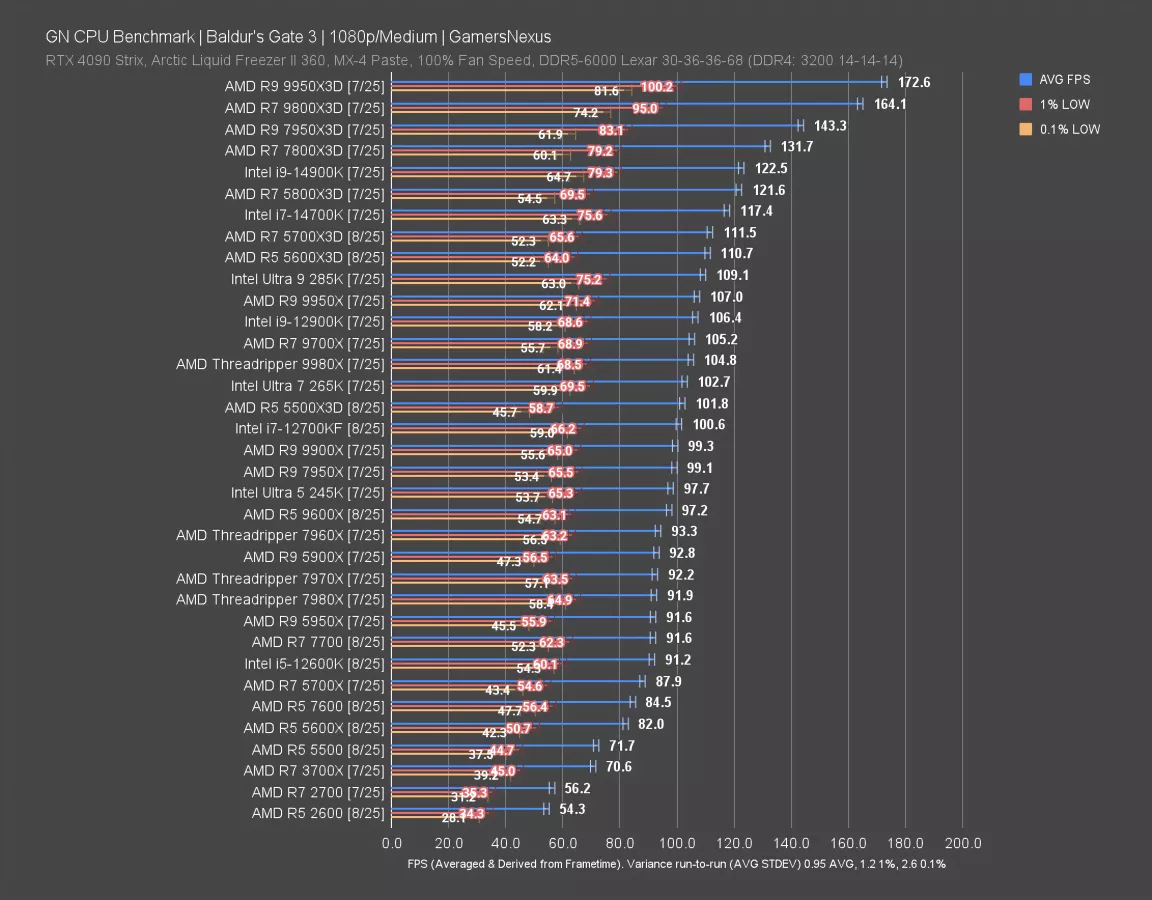
Baldur’s Gate 3 is up now. This one is lightweight on GPUs, but can be surprisingly good for showing CPU scaling. The 9950X3D (read our review), 9800X3D, and everything below them prove that. We’re still scaling all the way up to the best two CPUs on the market.
The 5500X3D held a framerate of 102 FPS AVG; however, these are slightly worse than the lows from the neighboring two Intel CPUs. The 265K and 12700KF both are better in frametime consistency, despite the 5500X3D not being bad.
The 5800X3D leads the 5500X3D by 19%. The 5600X3D and 5700X3D are similarly ahead of the 5500X3D, both at about 9% ahead of the new CPU. The 4GHz clock and 6 cores of the 5500X3D are limiting it here, despite overall fine performance.
Final Fantasy XIV: Dawntrail 1080p
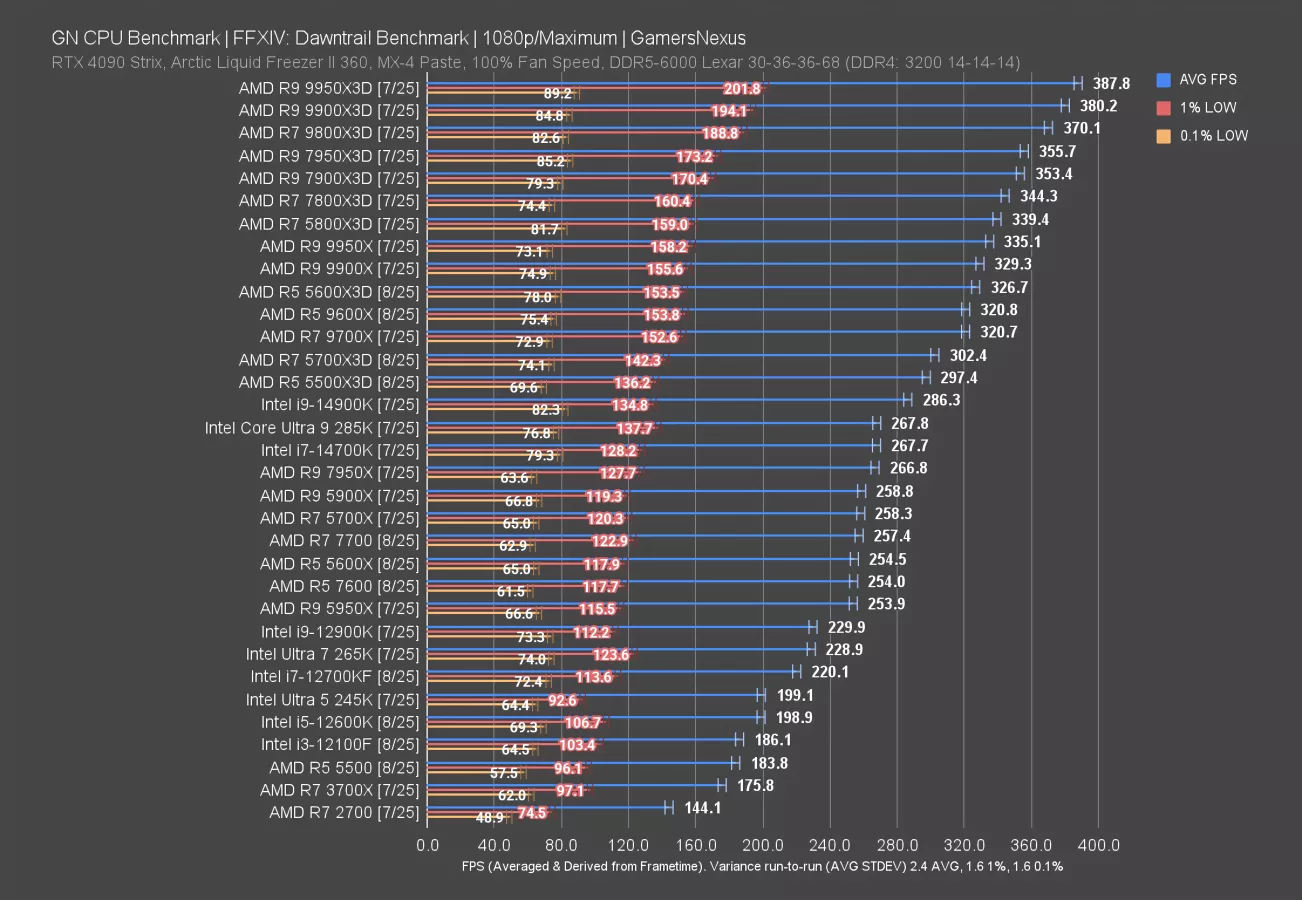
Final Fantasy 14: Dawntrail is up next, tested at 1080p first. The 5500X3D ran at 297 FPS AVG, so nothing to be upset about. Frametime pacing is overall good. The 5700X3D is technically better, but not by much; its 302 FPS AVG is an uplift of 1.7%, with the 5600X3D benefitting from the higher frequency. We’ve seen this behavior in Final Fantasy for years now, where the higher frequency helps more than an extra 2 cores.
The 9800X3D helps establish a ceiling around 370 FPS AVG, with the 9950X3D pushing close to 400 FPS. There’s room to scale here.
The 5500X3D manages to outperform the 14900K (read our review) and Intel 285K (read our review). We’ve talked about this before, but Final Fantasy’s chart flipped from an update a couple years ago now: It used to be that Intel held the entire top half of the chart, and now it’s AMD. That remains true with the X3D AM4 parts while the non-X3D AM4 variants fall below some of the Intel CPUs.
FFXIV 1440p
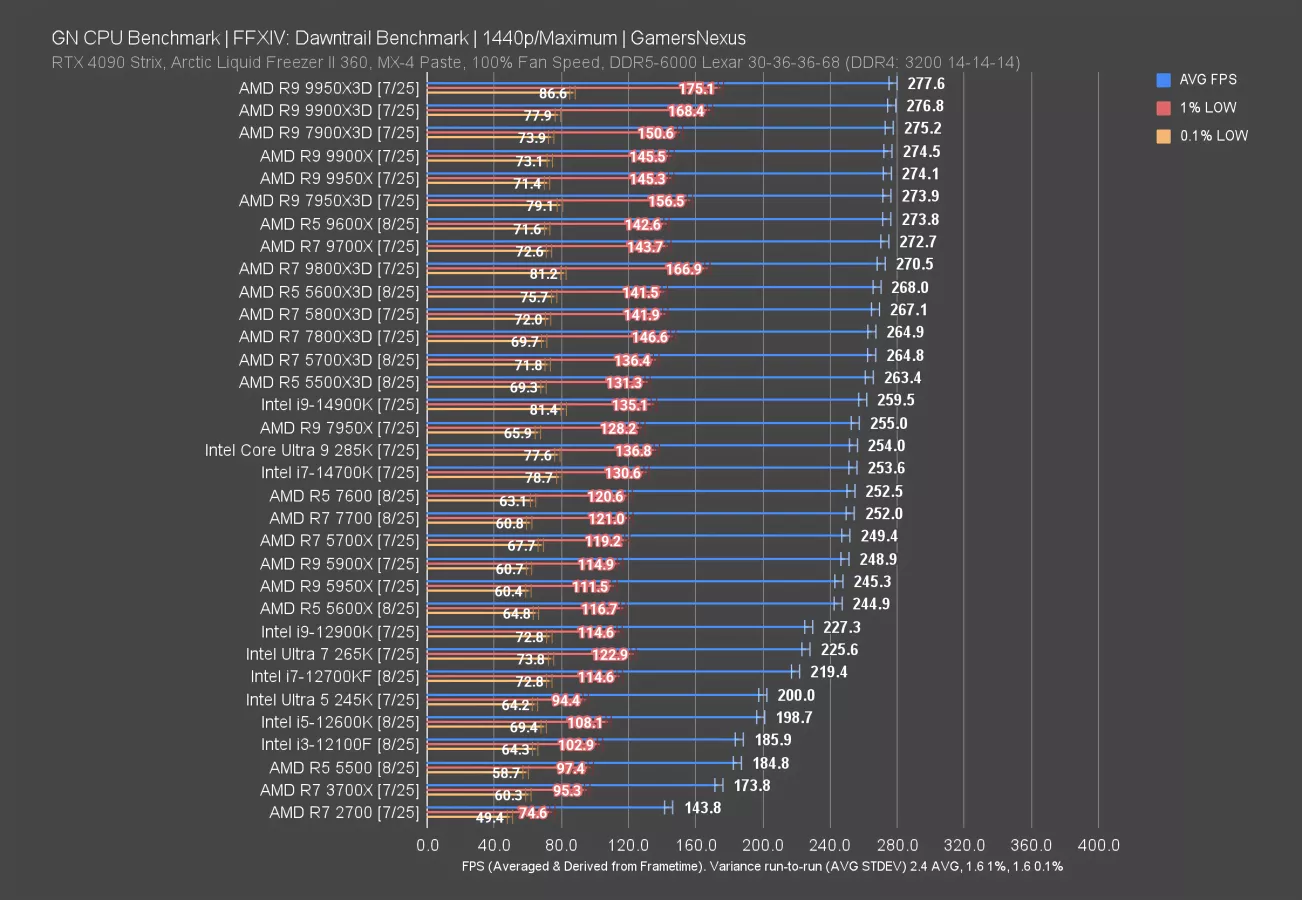
1440p is more or less the same, but we’re including it just to show scaling. Everything is a little bit truncated by the imposition of more GPU load, but particularly the 9800X3D and 9950X3D. These two CPUs are now about tied, with everything down to the 7600 (watch our review) at least occasionally glancing off of the GPU limit, even if rarely.
F1 24 1080p Benchmarks
F1 24 is next.
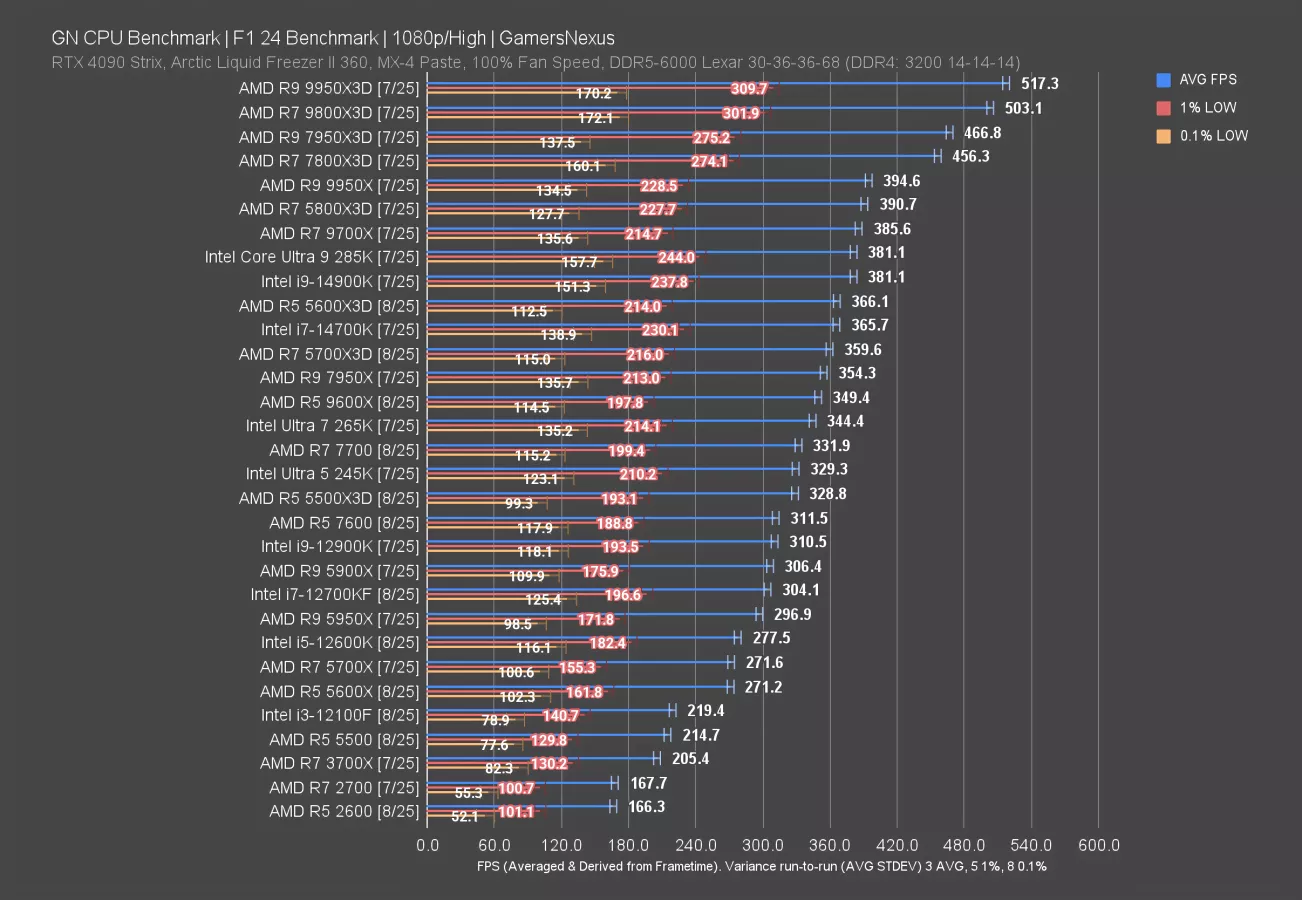
In this one, the 5500X3D ran at 329 FPS AVG and slightly outperformed the AMD R5 7600 while roughly tying the Intel Ultra 5 245K. Intel manages better 1% lows than the 5500X3D.
The 9800X3D holds a 500 FPS AVG result, a 53% improvement on the 5500X3D. Clearly there’s room to be better, but the last-gen 5700X3D and 5600X3D would be closer comparisons here. The 5600X3D outperformed the 5700X3D marginally from its frequency advantage, whereas the 5700X3D will be benefitted in more thread-intensive tasks. Both of them outdid the 5500X3D, with the 5600X3D improved by 11%.
Cyberpunk 2077 Phantom Liberty Benchmarks
Cyberpunk 2077: Phantom Liberty is up next.
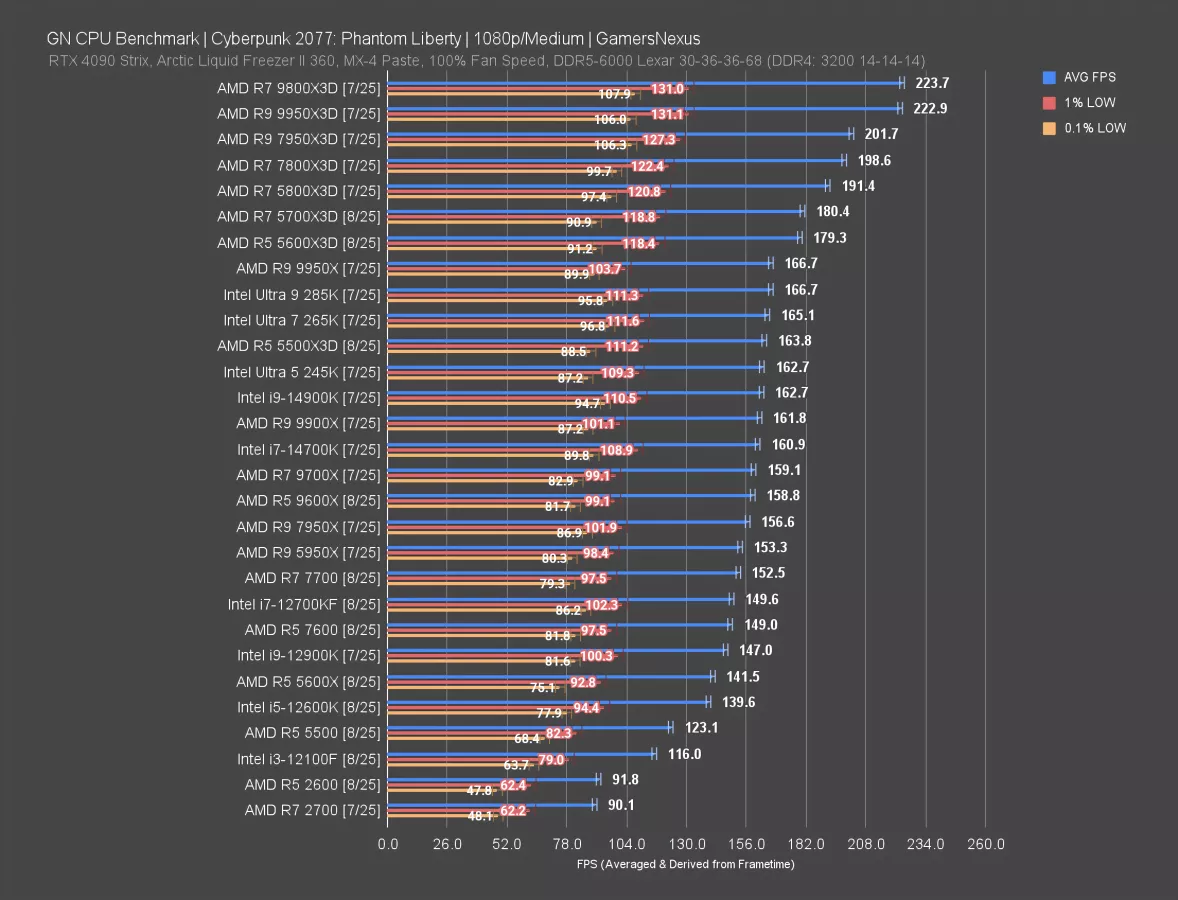
The 5500X3D ran at 164 FPS AVG, leaving the normal 5500 in the dust at 123 FPS AVG. The 5500X3D’s frametime pacing is also overall consistent and tied with the Intel 245K. The 265K is basically the same performance as the 5500X3D.
AMD’s 5600X3D outperforms the 5500X3D by around 9%, the 5700X3D is almost 10% higher framerate, and the 5800X3D outdoes the 5500X3D by 17% for average framerate. The 9800X3D is 37% ahead, bouncing off of a GPU limit alongside the 9950X3D.
The 5500X3D still outperforms the 14th generation and the non-X3D CPUs of multiple AMD generations, including the 9700X. X3D does well here and holds the entire top quarter of results.
Starfield Benchmarks

The 5500X3D does fine in Starfield as an objective measure, but isn’t competitive. The CPU runs at about 119 FPS AVG with unimpressive lows, although that’s mostly from the game.
The CPU is at least significantly better than the R5 5500’s 88 FPS AVG and the 5600X’s 99 FPS AVG, despite allowing the 5600X3D a 10-11% lead. The 5700X3D pushes past the 5600X3D in this one, illustrating a benefit from the extra 2 cores even with the lower clock speed. The ceiling in this test is around 200 FPS AVG, with the 5800X3D being AM4’s closest CPU to that result at 148 FPS AVG, leading the 5500X3D by 24%.
5500X3D Production Benchmarks
Blender
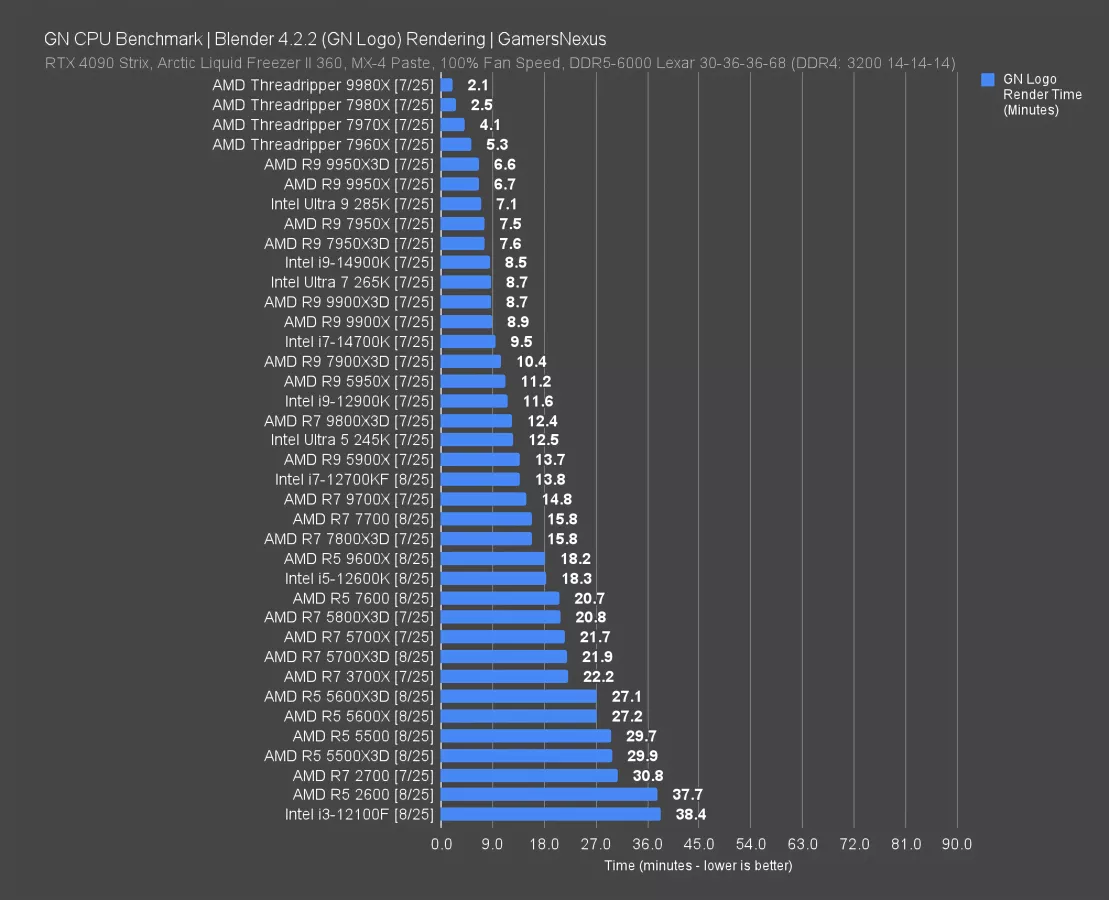
We’ll look at some production tests now. This won’t be as extensive as our Threadripper review, but will at least give us an idea as to the performance in non-gaming tasks. X3D doesn’t tend to help here, and in the AM4 generation, the configurations are often worse than non-X3D variants due to lower clocks.
In Blender rendering of a 3D GN logo, the 5500X3D required about 30 minutes to complete the render of one frame from our intro animation. That has it slightly behind the 5500 non-X3D, although they’re about the same. The 5600X (watch our review) sees a reduction in time required of 9% thanks to its higher frequency. The 3700X outperforms all of these as a result of the 8-core configuration, which offers more in this workload than just frequency at lower core counts can. Overall, the 5500X3D performs like a low power 6-core CPU, which is what it is when the extra cache can’t be leveraged. The 12600K that it ranked alongside in several gaming tests is significantly and noticeably better here, up at 18 minutes for the same test. That’s a reduction in time required of 39%.
7-Zip Compression
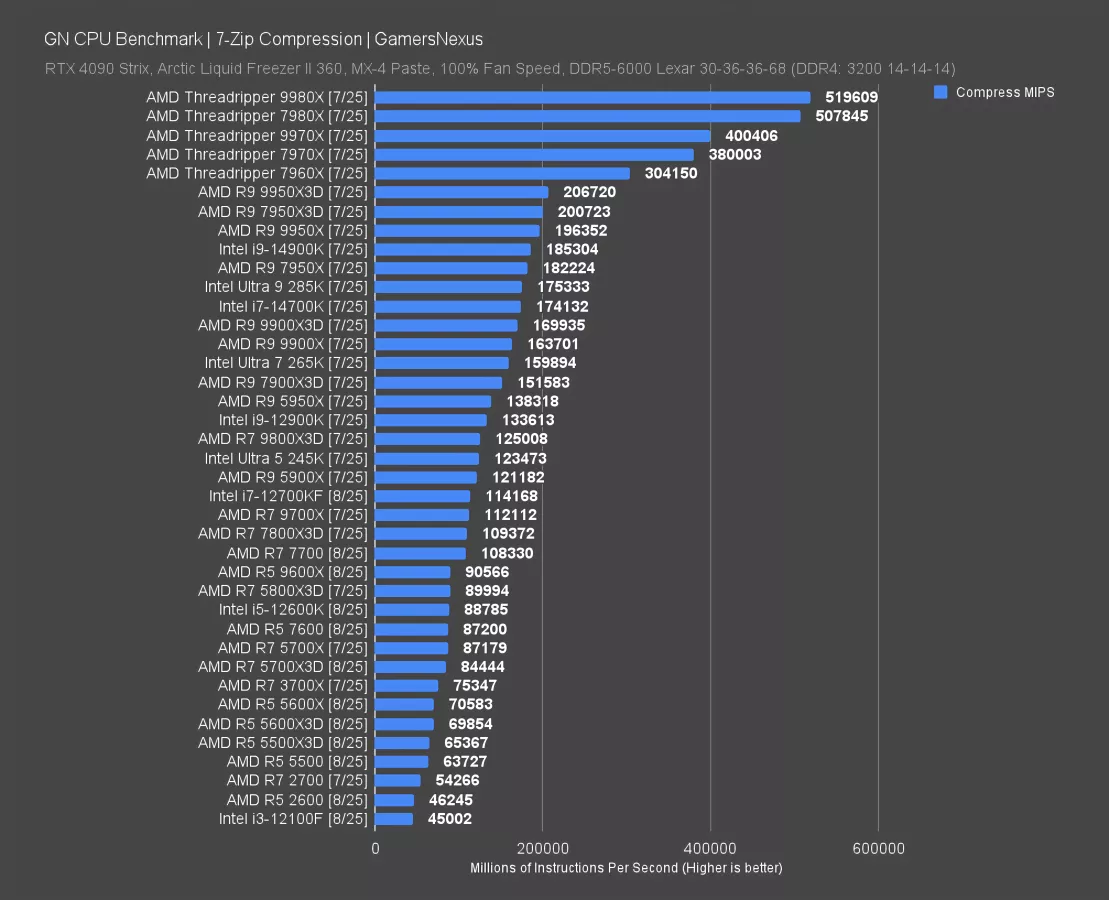
In 7-Zip compression testing, the 5500X3D ran at about the same performance level as the 5600X3D. Results are in millions of instructions per second, with the 5500X3D completing 65K MIPS, the 5600X3D at about 70K MIPS, the regular 5500 at 64K MIPS, and the venerable 5800X3D completing 90K MIPS. The 5800X3D and 5700X3D both benefit from a higher core count, with the 5800X3D in particular at 38% ahead of the 5500X3D CPU. The 12600K is similar to the 5800X3D in this test.
The 5500X3D isn’t impressive here in any capacity. There are better options for this kind of task, but if you had to do stuff like this in addition to budget gaming, it’d be workable.
7-Zip Decompression
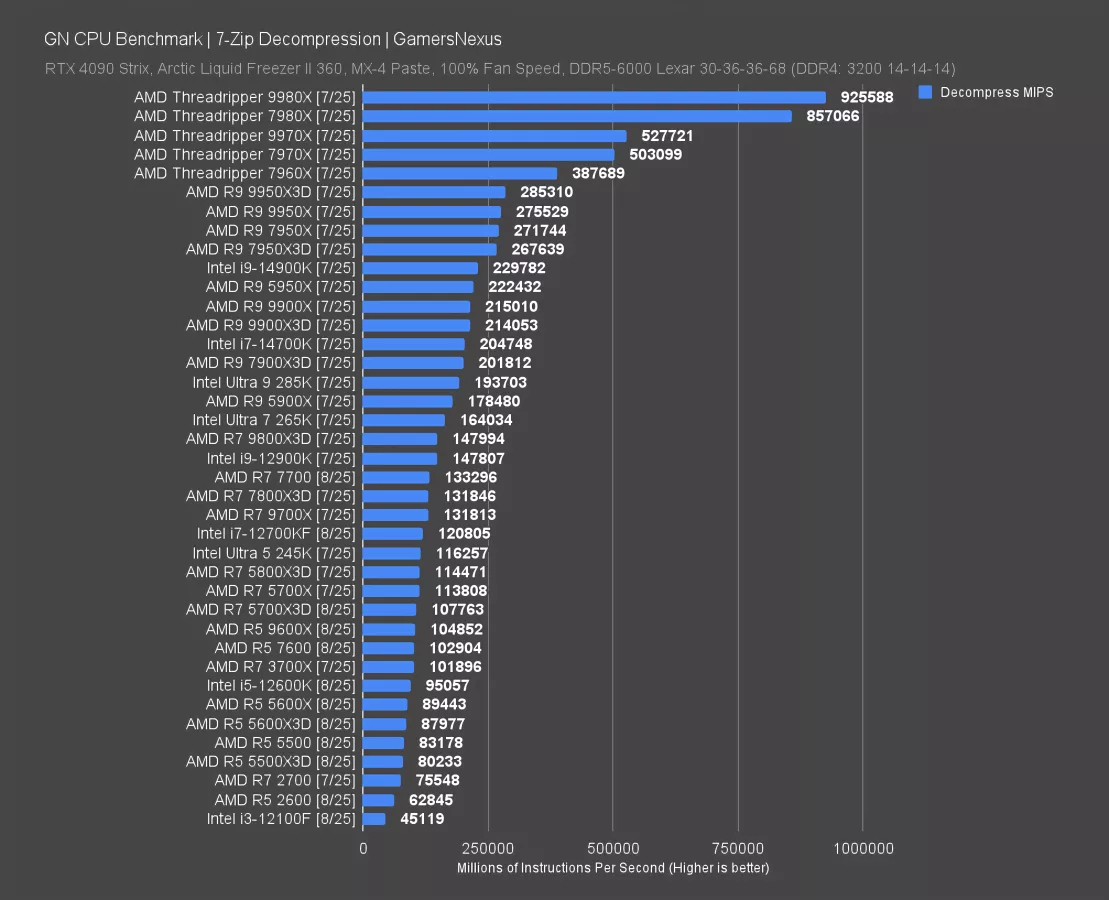
Decompression is next. This test has the 5500X3D at 80K MIPS, landing just below the R5 5500, which benefits from the higher frequency that we showed earlier.
The 12600K leads the 5500X3D by 18%, so where they were similar in a few games, the 12600K definitely has an advantage in these more core-intensive tasks.
The 5500X3D is not a good CPU for this kind of work. It can get it done, but it’s not competitive. This is primarily a budget, cut-down gaming CPU.
Chromium
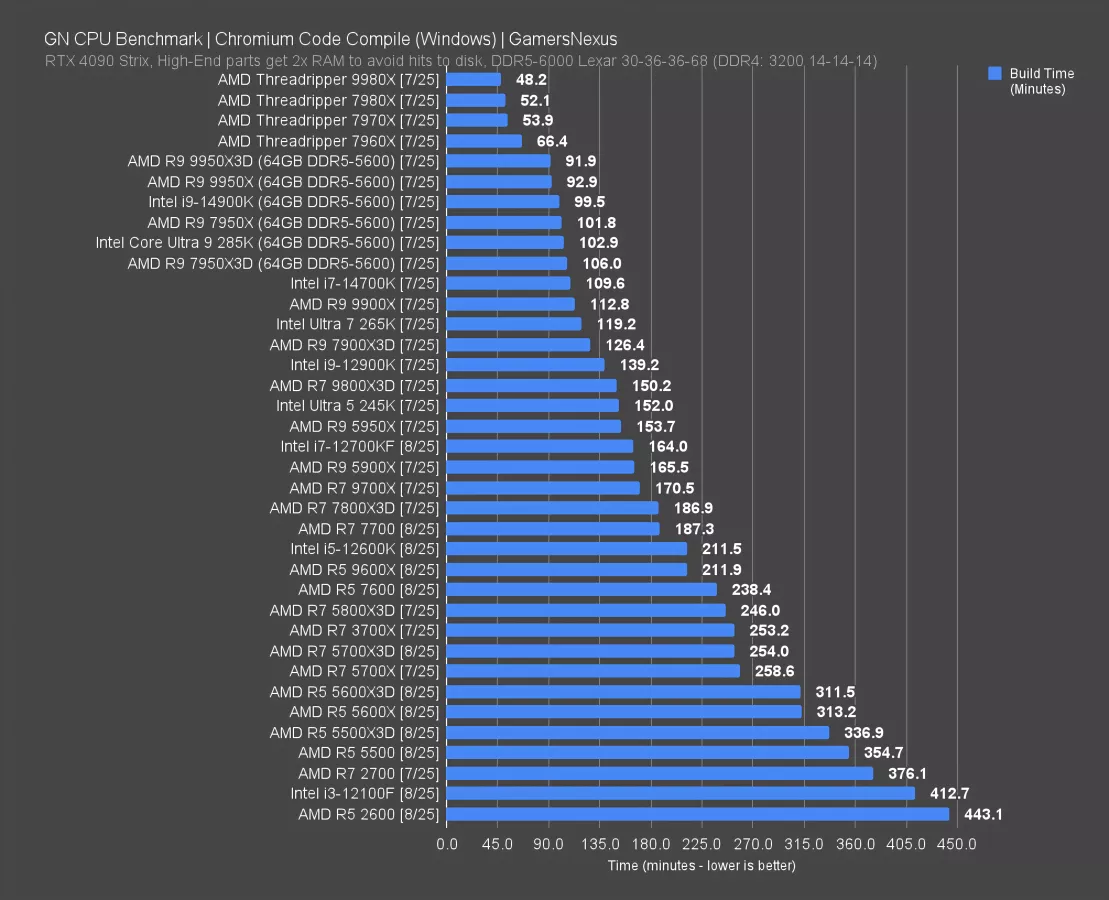
Chromium code compile is next. This test is extremely core-intensive and beats up the 5500X3D. It required 337 minutes to complete the code compile. That’s faster than the 355 minutes of the 5500 non-X3D, but still far down the chart. The 5600X and 5600X3D show similar rankings, with the 5700X3D also benefitted over the 5700X non-3D. There’s at least a clear trend in these AM4 CPUs of the extra cache helping versus their non-X3D counterparts.
Adobe Photoshop
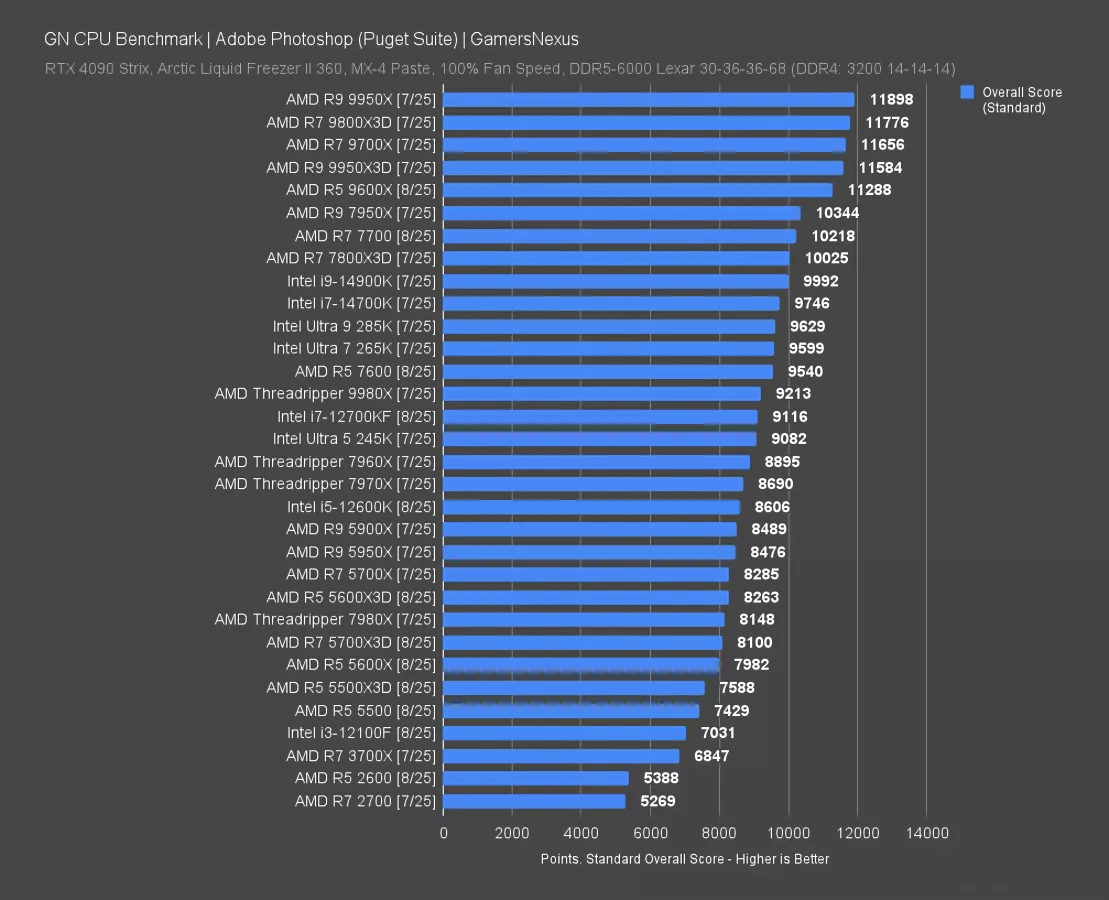
In Adobe Photoshop with the Puget suite, the 5500X3D lands again at the bottom of the chart. It’s ahead of the 5500 non-3D but behind almost everything else, including the gaming neighbor 12600K.
Adobe Premiere
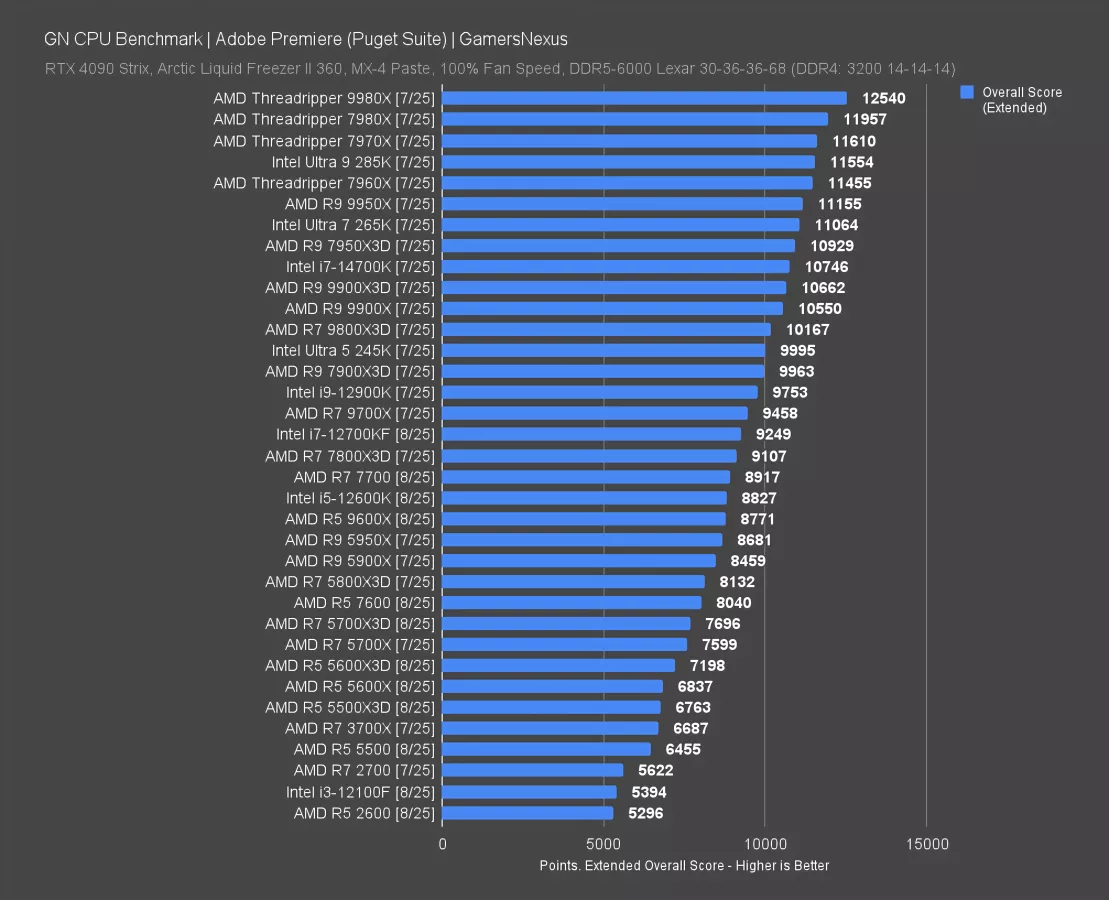
Adobe Premiere video editing and rendering tasks via the Puget suite have the 5500X3D at 6760 points extended, which plants it between the 5500 and 5600X again. The 3700X isn’t far off from the 5500X3D’s performance, mostly thanks to its extra 2 cores.
The 12600K is significantly better than the 5500X3D here, as are basically any options from the AMD 7000 series and beyond. The generational uplift was particularly large in this test.
DaVinci Resolve
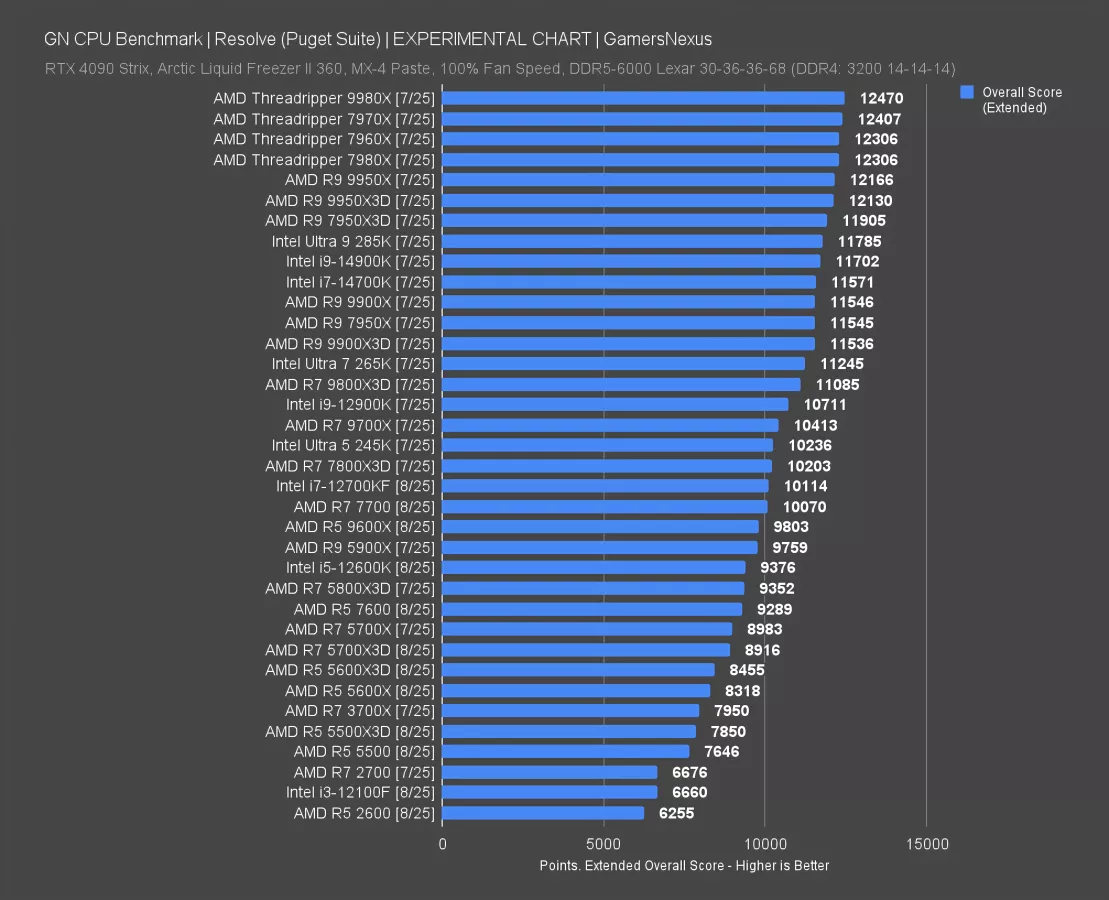
In DaVinci Resolve, which is experimental for us right now, the ranking is similar: The Puget suite keeps it down toward the bottom of the chart, just behind the 3700X, 5600X, and ahead of the 5500 non-X3D.
Conclusion
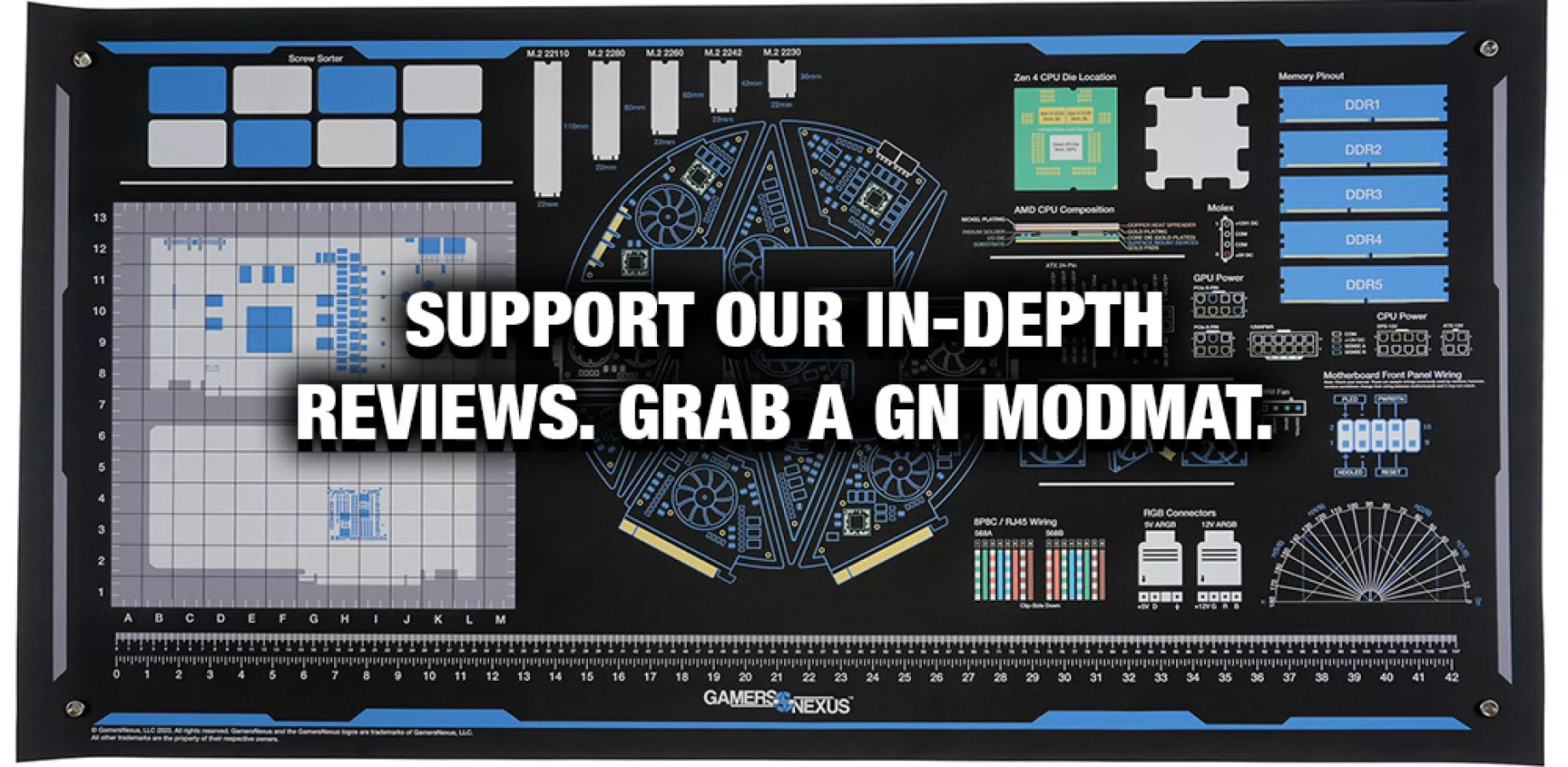
The CPU market is still relatively sane compared to the utter chaos that is the GPU market right now. CPUs are, for the most part, pretty stable—pricing is predictable, availability is decent, and while you might not agree with the price of a specific model, at least you know what you’re getting into.
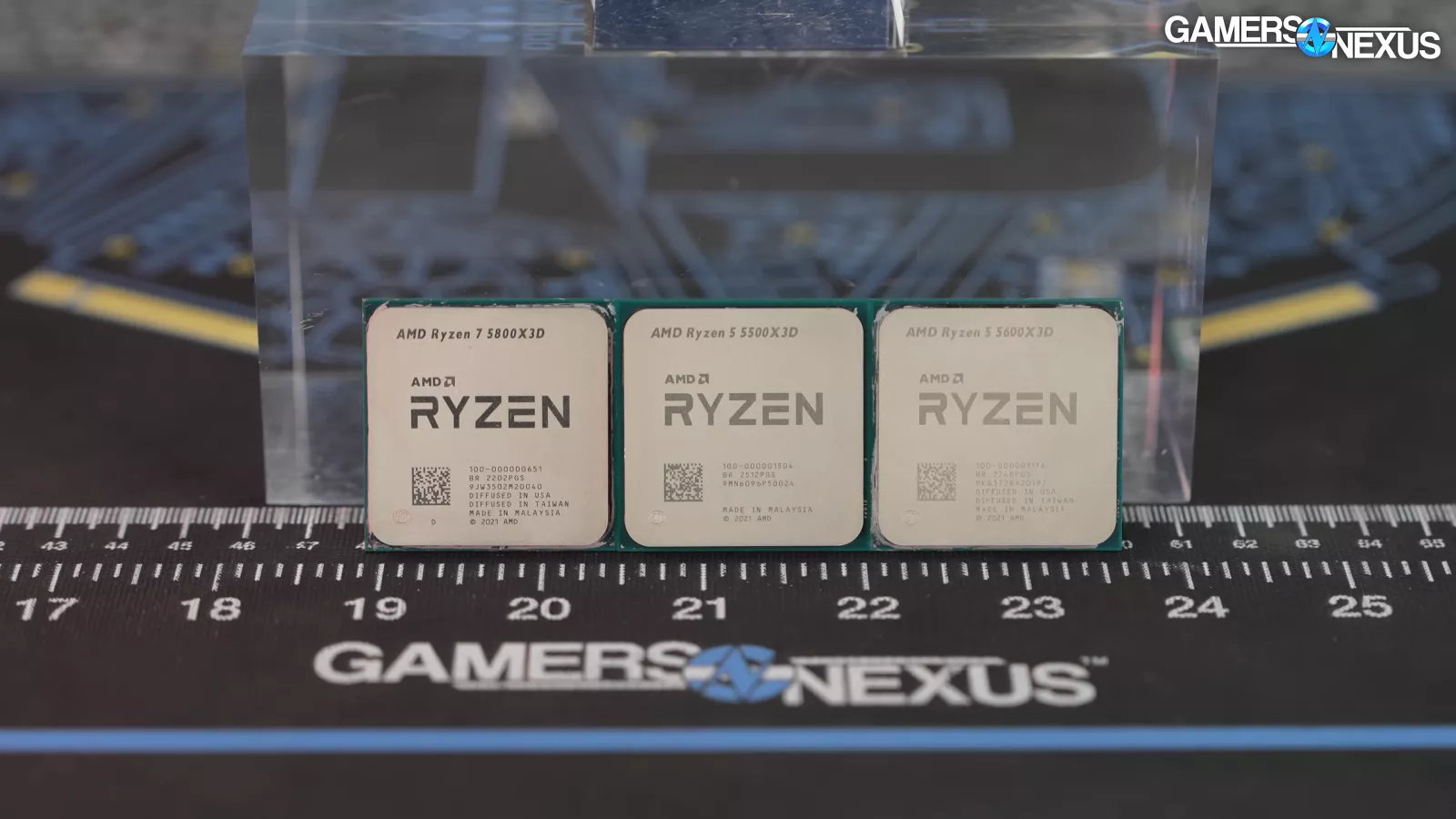
One of the most impressive things here is AM4. It’s still kicking, even with AM5 taking over. We’ve talked to motherboard vendors, and they’ve told us that older boards from past generations often get rerouted to markets outside the U.S., like South America and parts of Asia, where there is still demand. This helps keep prices a little lower and ensures that those boards don’t just end up in a landfill. And for folks looking to buy in, it means that entry costs for things like the 5500X3D are more reasonable.
Speaking of the 5500X3D, it’s a noticeable improvement over the non-X3D 5500. The biggest problem with that old chip was its tiny cache.
Performance-wise, the 5500X3D is fine overall and didn’t really fail in any of the games we tested. It isn’t a particularly good performer in things like production applications, compression, and decompression. It can do them, but it's not good if you’re doing those tasks heavily. In that case, you’d be better off going for a higher-core-count CPU.
Pricing is key here, and it really depends on where you are. In the U.S., the 5500X3D’s launch price of $240 to $250 felt a little too steep, especially with better alternatives on the market at similar prices. But if you catch it around $200, it’s a much better deal and competes with stuff like the 9600X, so it’s definitely a more appealing option.
What’s really impressive, though, is how AM4 is still relevant and kicking, despite being several years old. This thing has been around for ages, and AMD is still giving it support. AM4’s long life means less waste, fewer upgrades, and a platform that’s not forcing you to buy a whole new setup every couple of years.